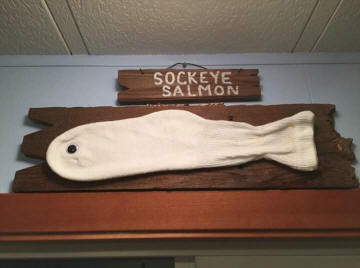
 |
Fishing Rod Holders |
|
If you are a fisherperson who fishes from a boat, more than likely you will be acquainted with fishing rod holders. I have seen many different styles in my 75+ years of fishing. The main priority is to hold the rod securely while yet having it readily available with minimal effort of removing it. Bank mounted rod holders are rather simpler.
Rod Holder Placement on a Boat : Those of you who troll for salmon may upgrade your hit to hookup ratio, by changing how you mount your rod holders. Most of the fishermen know (or should know) that when using downriggers that the rod needs to be set high in the air and/or to the side and arced rearward under the tension of the release clip to the downrigger wire. This arcing allows the rod, being under strain, to pop up when the fish hits, setting the hook.
| Here the rod is set in the holder at about the perfect arch, note the whale birds resting in the background |
|
|
Now, if you only use your rod holders that are mounted on the downrigger as a rod holder even when you are not using the downrigger for normal salmon trolling like Buoy 10, Willapa Bay or Johns River salmon fishing, you could be handicapping yourself. Think about it, here without the mainline attached to the downrigger wire/ball, if that rod is pointed high in the air and only using a 8 oz. sinker, the line is entering the water considerably farther back. Unless you are using a pool que rod that is strong enough to set the hook in conditions like this, the fish will just hit the bait, and by the time the slack is taken out of the line, with the limber rod (in this upright condition) could not got enough strength (backbone) to set the hook when the fish takes your herring, the fish may not get hooked 80% of the time. Here when a fish hits, the 9' or 10' rod moves in a long arc and you can have a 5' spongy movement of the lure. If you are using monofilament mainline, it's stretch will also add more movement. However if the rod is mounted lower and somewhat rearward, your fairly sold lure movement may only be 1' and the fish is hooked as it turns to go. If you just want to spend a day on the water, and do not have to clean that smelly fishbox when you get home, then disregard what I have said above.
For salmon trolling in conditions like Buoy 10, Willapa Bay or Johns River in Washington or Tillamook Bay in Oregon, where you could be using a diver or cannonball sinker, it has been found that the rod needs to be mounted low (almost parallel with the water or slightly higher) pointing sternward at about a 45 degree angle as seen in the RH photo farther down in this article.
You may go on for years thinking of racking your brain for many things on how to increase your hookup ratio, like changing to a different style of hooks, going to braid mainline or a multitude of other trials. And all the time it was simply how you mounted your rods.
Others may disagree with me here, saying that when the rod is higher and more straight out that this line spring gives the fish time to not feel the rod's resistance, then turn and get self hooked (maybe). However for those fisherpersons that do have a better hookup ratio, my bet is that they are making up the difference in the type and heavier power of the rod that they are using. Or they are concentrating on Coho which seem to be a more aggressive biter and usually get self hooked.
|
Low mounted rod holders for normal trolling using longer rods & heavy sinkers |
Here the rods are mounted high, with little tension on the rods, and at this line angle how much line do they need out to achieve any depth? |
|
|
|
Many Rod Holders to Choose From :
Some rod
holders are good, others not so good and others simply so cheaply made that they
are are only good for trout, or if used for salmon, may only last one trip.
The early ones were simply made on a modification of a carpenters C clamp with a
fork on the outside with a open hook mounted lower on the inside. In use
you laid the rod in the fork bringing the handle down and under/into the hook.
These could be moved as desired, but just never seemed to be sturdy enough if
you were after anything much more than a trout sized quarry. Most of these
were imported being made of a thin metal stamping. I have one USA made that was basically the same
design but was a brass casting as shown below on the left, which was probably the
one the later ones copied.
The one problem with most rod holders is that IF A LARGE fish, like a salmon or sturgeon takes the bait and is pulling hard while the rod is still in the holder, some fisherpersons have problems removing the rod from the holder. From my observation, this is usually inexperienced fisherpersons OR those who do not have a lot of strength in their arms or shoulders, plus they don't really understand that the rod has to be slightly lifted up (under the fish's strain) as it is pulled forward and out of the holder. And in the height of excitement, they do not realize the rod has to come out in exactly the reverse order it went into the holder. There are a couple of rod holders now that have been designed around this situation.
Simple Clamp on Holders ; Currently made Danielson, Bass Pro and others shown in the photo on the right; This simple design has been made for over 50 years by various makers, allows you to quickly attach these rod holders to your boat or dock making it easier to fish with multiple rods. Constructed from stamped sheet steel, or die-cast aluminum, these portable rod holders are fully adjustable. The standard size rod holder fits up to 1-5/8’’ diameter rods, and the clamp fits up to 2-1/4'' gunnales.
| This old solid brass unit is a Totem model made by Barco Mfg Co. & was used then when I got it from my uncle about 1965 | This type has been around for many years & is a cheap steel somewhat copy of the one shown on the left. |
|
|
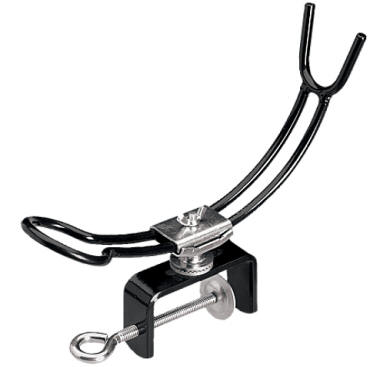 |
Down East ; According to the website, in 1946 Down East Sportscraft http://www.down-east.com/ devised a holder that used the DownEaster name. I came across these about mid 1960s. In my book they were the forerunner of some we have today. It again used a C clamp type base, however this was substantially made of a die-cast aluminum type metal. The base clamp had 2 pivot bolt locations and shallow Vee notches so the holder could be adjusted depending on the gunnel it was mounted on. There are also other bases available. Above the clamp was a cup that had internal notches with a clamshell type holder that sat in the cup. It could be rotated 45 degrees in any direction. In use, all you needed to do was lift the rod straight up and the clamshell opened releasing the rod. The clamshell is stopped from coming out by a cross-pin near the bottom.
Plath / Danielson ; Then in the late 1960s along came a cast aluminum tube with a angled attachment pin about midsection pointing down which went into a base that had 3 sides that mated the holder allowing you to pointy it 45 degrees to the right or left and straight out on the other side. This base unit was made slightly tapered so with any tension on the unit it would simply get tighter. This unit was very well made as it used a stainless knurled bolt at the bottom to retain the unit to the base. The name was Plath Specialty Marine Hardware of 337 N.E. 10th Avenue, Portland Oregon.
These could be used with the base either on the flat or side of the gunnale, utilizing either end of the holder as top. The base and the holder were slightly beveled to mate so that when setting bottomed out the holder was wedged into place.
Plath apparently went out of business and Danielson came out with a poor copy. Danielson tried to copy it but cheapened by using a smaller headed lock screw that once it became exposed to salt air, the screw became impossible to loosed without the use of penetrating oil AND a pliers. The bases did not usually interchange with the Plath and the holders did not usually interchange with the Plath because the stainless steel pivot was never drilled in the same location on each one during manufacture. These were finally discontinued about the early 1990s. The Danielson's can further be identified by a more abrupt diameter change on the ends as the Plaths body and ends were blended in.
| Plath #865 pointing rearward | Plath #865 pointing at a 45 degree | Danielson copy of the Plath |
|
|
|
|
Fish On ;
Tempress
http://www.tempress.com/ started
making their Fish On rod holders in 1972, and even before the patent ran out,
there were knock off copies. This method utilizes a base that is either
bolted or clamped onto the boat using a splined center hole that receives the
holder itself that can be positioned in about 10 degree increments of rotation.
These are made of a high impact plastic. These have the pivot shaft which also has the splines that give you about any rotating
position, but at the bottom of this shaft
is a notch that matches a small nub/bump in the base which acts as a retainer. To install
the 2 together you need to rotate the holder 180 degrees so that a bump inside
the aligns with the notch, then rotate it back to your desired position, then
push it down into the rotational position notches.
This provides a positive stop for the upper part of the holder will not be accidently
pulled out of the base.
Let's back up a bit
here, the early versions did not have this notch and the 180 degree locking
system, but used a sliding lock on the base. These can be identified by a
white sliding lock. In use, the holder was simply inserted at any
position, the slider lock then retained it by a ring on the bottom of the shaft.
In the RH photo below, you can see the white slider lock inside the hole, where
the newer base has a nub.
Newer 180 type locking
uppers can be used in the older bases, but the older uppers would need to have
the notch cut on the very bottom to be used in the newer bases.
| Tempress Fish On, with oldest style on right | Tempress Fish On vertical view |
 |
 |
These Fish-On units have a cut out on the outer end allowing the rod to lay in, but with the rear encircleing the lower part of the rod handle below the reel. The weight of the rod and the line going downward puts enough pressure that the rod will not come out on it's own. There is a separate white plastic removable rotating lock ring on the forward end that you can rotate, entrapping the rod until you rotate it back. This ring is an option that can be utilized or not, some even remove it completely, which is most commonly done.
| Tempress Fish On model with the rotating lock in place | Tempress Fish On rod holder in use |
 |
|
These rod holders appear to be made for usage with trout type rods so when you try to use a salmon rod that may have a larger fore-grip, it can be a snug fit, getting the rod out readily can then be an issue. Therefore if you are using larger salmon size rods larger than trout or steelhead rods, you may need to remove the rotating lock ring, then cutting the upper front inner edges back at a angle, then slightly widen the slot to accommodate the larger rod's front cork handle as seen in the LH photo below. This of course is then no problem when using a smaller trout rod. This alteration has worked great for me when targeting many specie for a number of years.
The RH photo below was taken off a Pacific Northwest salmon/steelhead guide's boat, here he has chopped of a lot off the front to accommodate various rods AND at the same time make it more readily accessible for his clients who may not have been experienced in the lift up and out method of quickly removing the rod. To reduce any sharpness at this cut, he has seared these cut edges with a propane torch, just slightly melting and rounding the cut section.
| Tempress Fish On, with front modified for salmon rods |
Tempress Fish On,
Chopped off, for using smaller rods |
|
|
|
Apparently when the manufacturer found out about some salmon, sturgeon rods had a larger forward hand grip, they modified the holder's forward section, but leaving the very front still the same size.
| Here you see the newer upper holders |
Some fishermen complain of the Fish On holders can become loose and not be able to be/stay locked into a single vertical position. Well, on the LH side and inside the large white locking knob is a black LARGE slotted screw head. This is for adjusting this vertical locking. With the white knob backed off, tighten this inner screw, then try to tighten the knob which needs to cam over and keep pressure on the top part of the holder to the bottom base. You may have to make numerous tries, but this takes up the slack. This method salvages many of the the garage sale rod holders.
Fish On Copies ; There are now more than a few knock offs of this type that interchanged, a couple being Danielson, Action Outdoor Rod Tender and Roberts products. All of these holders do not have the rigidity, strength or flexibility of positioning the holders a the Fish On does. And some do not use stainless steel fasteners. The bases seem to be pretty much interchangeable however, but not with Scotty.
| Action Outdoor Rod Tender |
 |
Scotty also makes a similar one, but it uses the retainer knob on the opposite side of the base hole. This could allow the rod holder to become dislodged and come out under the wrong conditions. Also Scotty's splines do not really match the Fish On as the Scotty are just enough smaller that you have to force the Fish On into the splines. They retail for over $20 each.
|
Scotty Baitcaster/Spincaster Rod Holder Model 280 |
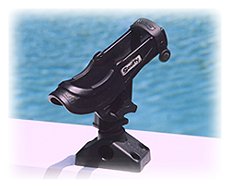 |
Cabelas also sells the above rod holders which were made by Scotty but with Cabelas name on the upper section, and Scotty's on the base.
Scotty has recently come up with a copy of the Folbe shown below.
Folbe ; Folbe http://www.folbe.com/ makes one similar to Scotty only more sophisticated using it's own style of splines, bases and holders. These act like clamshells and can be adjusted in about any position, plus either RH or LH depending on the side of the boat it is being used on. One side is stationary, while the other side pivots out. These are a simple lift it straight up type and are very efficient with little effort required, it is best to use two hands, lift the rod with the forward hand and push down with the rear. They have a base lock so can locked in a rotated position. The secret to understanding usage of them seems to be that you need to set them so that the solid portion be facing rearward thereby allowing the clamshell portion to freely open up.
Many dedicated salmon fishermen swear by these after they get used to them where the need for a quick rod pickup is desired.
| Folbe |
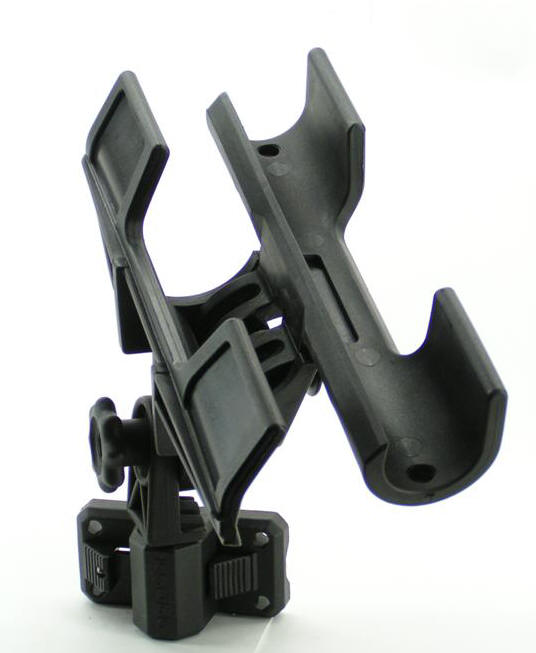 |
You will hear the debate over the benefits of a Folbe over the others as far as the ability to grab the rod and remove it from the holder. Folbes allow the clamshell to open up by just picking the rod straight up. Using the others you have to lift it up/push out all at the same time, this can and has been done many times yet hook the fish even if the fish is running. They also run the chance of loosing a rod. I hear that using these others that the fisherman may be unable to get the rod out of the holder without losing the load in the rod and throwing immediate slack to the fish then loose a fish especially with barbless hooks. And even among veteran fishermen, a significant number have neither the muscle nor the strength to do it consistently.
However I can see the benefits of the Folbe when being used by a novice, from the side position 90 degrees to the boat and when the reel is geared up with no-stretch superline and barbless hooks. These are the folks that will overwhelmingly benefit from the elegant and effortless release from a FOLBE Advantage rod-holder.
I for one
an not fond of them. Maybe it is that I am so used to using the other
SIMPLE type, and I have no issues of pulling the rod OUT and then UP,
instead of just the UP of the Folbe. However I have found that
there is a trick to get it to lock the rod in, seems that it has to be just
in the right position to slide down and lock up (especially if your rod has
a trigger). Probably any faults here
would be operator error. However, I lost a new Lamiglas rod and Diawa line
counter reel overboard in 2022 because I apparently did not get it locked in,
and when a fish hit my lure , he stole may rod and reel, worth a total of
about $350. Apparently I did not double check, and the holder was not
completely closed, -- thereby not locked. BE SURE it is locked in and
set right. My fault, but if I have to be that precise, no thank
you, I will stay with my Fish-Ons.
Well I guess it is what you have
become accustomed to using. There are some of us out there who will stick to
their old school technology and still seem to catch fish.
Stealth QR Rod Holders ; There is a new player in the rod holder game as of 2015. Stealth http://www.stealthrodholders.com/ is a family owned business in the south eastern USA that has come up with a somewhat newer concept. Theirs is called the Quick Release model and utilizes unique holding system as seen in the RH photo below. This rubber strap is designed to allow the rod to lay on it, and when pushed downward, engulfs the rod in a secure position. They seem to be well made, but are limited somewhat by the size of rod that can function well at release time, unless you only put the handle of a salmon rod in, leaving the reel forward of this unit. They do have a rubber strap that can be snapped onto a peg on the opposite side to secure the whole thing if needed.
| Stealth QD-1 side view | Stealth QD-1 front view |
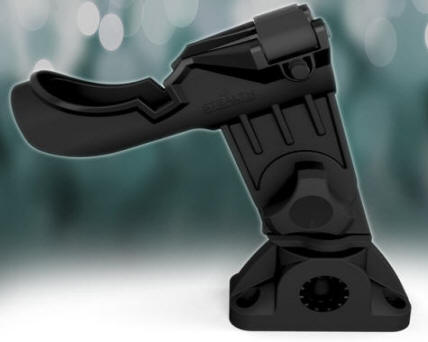 |
 |
This unit has some good features for some fisherperson, but also some drawbacks. I can see these a a good unit for some methods of fishing, especially from kayaks. However the drawbacks I noticed in my trying one out was (1) The size seem to be made for smaller fishing rods (not long enough horizontally for normal salmon rods). (2) When using a levelwind reel and the newer rods (last 20 years) are made with a trigger molded into the rod's reel seat. In using this type of rod, in these holders, upon lifting the rod up/out of these holders, the rod’s trigger hits the rear of the rubber retainer. It would be nice if they were made about 3" longer on the forward section, which could alleviate this situation. (3) The holder stud's internal retainer notch is positioned at 90 degrees, all others are 180 from a straight outward rod position. In use, if this base is mounted on the inside starboard gunnel and the holder is positioned straight rearward, this retainer notch is then aligned with the retainer lug AND when lifting the rod up, you could have the holder be totally disengaged and lost over the side. (4) The base is compatible only with Scotty or Cabelas, so if you are currently using Tempress Fish ON units, they are not compatible. It would be nice if they offered a stud/base that would also fit the Fish ON units.
Simple Home Made ; Got a small boat, or on a budget? You can fabricate a simple, functional rod holder out of PVC pipe as seen below, may require some experimenting however to get the tight angle position. Nothing fancy but it works for smaller rods.
| Here we see a simple Home Made PVC holder |

|
Quick Release ; Here is a different idea. This is a conversion kit that can be made to fit the popular Fish-On or Scotty regular rod holders, converting them to a quick release. It is a patent pending idea by Merrell Sager of Olympia WA. His method is to cut the top rear section out of the existing rod holder, place, then pop rivet a PVC pipe coupler in the bottom rear section. Then add a stainless steel hinged cover, utilizing the cut out plastic rear, but also adding a spring loaded thumb latch. In the top center he has added a rubber button which with the rod in place and the latch secured, locks the rod in place when latched. The thumb release lever has a plastic covering. This is quick and simple. You can even unlock the rod without moving it if you are having a bite. All you need to do is press the lever with your thumb as you grasp the rod handle and lift up.
The only thing I see negative on this design is that the operator has to BE SURE the latch is snapped in place and this could depend on whether or not the same rod was used in the holder which was adjusted to initially fit.
Merrell is trying to find a business to manufacture these conversion kits in quantity so he doesn't have to do them all by hand. To contact him CLICK HERE.
| Quick Release conversion on a Scotty | With rod locked in place | With the unit unlocked ready to lift up |
|
|
|
|
Tube Type ;
Then there is the
simple pipe type holder. These are generally used by the charter boats
because they are sturdy and are usually clamped onto the railings. Other
chrome or stainless steel versions have dual positioning bases that attach to
pipe type railings.
You will also see this type used on overhead radar arches as seen below on the right, and if being used there, they are many times referred to as "Rocket Launchers". These are not for holding rods when fishing, but for transportation or storage of spare rigged rods, yet being readily available, or a place to put a rod up out of the way when fighting/landing a fish on the other side of the boat. On this tower, you will also see a Furuno radar dome, docking lights pointing forward, rear deck lights, a USCG rear/white light, grab bars and a crab pot davit mount or net holder.
| Tube type, rail clamp | In use here, these rod holders are nicknamed "rocket launchers" when mounted on a tower/arch |
 |
|
Do not even consider just setting a unattended rod (for even 30 seconds) against the gunnel. I have seen a couple of rods lost this way. It is rather a hopeless feeling to see a rod go skipping across the water and then disappear. And if you recover one of these, you are very very lucky (which I have done twice out of 4 times losing one). The word is you just donated a nice rod and reel to the Fish Gods.
Holders in Use ; In using rod holders, the trend has been toward some form of making them a Quick Release. This can have many benefits, but sometimes can be confusing to the uninitiated fisherperson. In downrigger fishing, depending on the depth of your gear and the amount of blowback your fishing line has, when a fish hits, there can be a time lag before you can get the rod out of the holder and get line slack taken up that the fish has a good chance of becoming unhooked especially when using barbless hooks.
A better method when using any type is to get accustomed to, when a fish hits is to leave the rod in the rod holder, but IMMEDIATLEY, grab the rod handle and REEL, REEL, REEL until you make solid contact with the fish, set the hook if needed and then while holding the rod so you do not loose contact with the fish, remove it from the rod holder and start your fight.
Obviously this would not pertain if you had a SOLID take down and the rod tip was buried into the water, where you had a hard time even removing the rod from the rod holder under the strain of a large fish.
Bank Type Holders ; These can be as simple as a forked stick poked in the bank, to more elaborate ones like the ones shown in the photos below.
This one shown on the left is made from 3/8" X 3/4" steel bar with a light angle iron step welded to the bar. This step allows the user to use it in sand or even gravel without the use of a sledgehammer. The rod holder bases are simply a 1 1/4" PVC pipe cap taped to the bar. The upper cap is for regular fishing rods as shown, while the lower can be used for larger/longer surf casting rods. The upper C shaped holder part is a PVC pipe coupler split to allow the rod to be withdrawn more readily, it is held in place by a single 1/4" bolt and can be rotated to the other side when needed for the larger rod. This combo holder is sturdy and simple to build.
Other simple holders can be made from 1" angle iron with PVC pipe taped to the steel, or like the old garage sale ones shown on the right hand photo. Here the left one is basically an adaptation of the early ones used on boats, while the right is simply a piece of tubing welded to a long sharpened rod. The snap appears to probably have been an adaptation to use a bell or some "wake up" device.
| Here is a Home-Made holder designed for bank fishing |
On the left is an old commercial rod holder & on the right, a home-made one |
|
|
|
The photo on the left utilizes two pieces of aluminum tubing, one as the actual rod holder and the other smaller that goes over the end of the chair arm rest support. This smaller one is secured by a single 1/4" screw (tapped into the smaller tubing) and to the arm rest tubing that has a thumb nut welded to the screw for convienience. It can be rotated up or down to fit the desired rod angle. The only modification to the chair arm is the slit the canvas to allow the smaller tube to slide over the arm and another slit to allow the set screw to be inserted. Shown is one in place on the chair and the other beside for reference.
The one shown below on the right could even be utilized as a bait holder.
| Here is a slight modification to a folding chair arm-rest to accommodate a welded aluminum tube type rod holder | Here we see a dual purpose Home-Made one |
 |

|
copyright © 2009 - 2025 LeeRoy Wisner All Rights
Reserved
Back to the
Ramblings Home Page
Originated 4-31-09, Last updated 08-28-2025
Contact the author
| Cabelas Quick Draw | Cabelas XR Quick Draw |
 |
 |